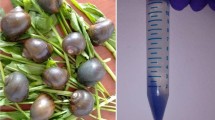Abstract
The photooxidation damage of lysozyme under 315–375 nm irradiation in the presence of riboflavin was studied by using sodium dodecyl sulfate-polyacrylamide gel electrophoresis (SDS-PAGE). Indications showed that the mechanisms and products of oxidative damage were relative to the concentration of riboflavin, the time of irradiation and the ambience. The type I process was examined in a nitrogen saturated solution, whereas both type I and type II were observed in an aerobic atmosphere and type II was the dominant process. The study also suggested that antioxidants, such as melatonin, can reduce the damage of lysozyme effectively.
Similar content being viewed by others
References
Viteri G, Edwards A M, Fuente J D L, et al. Study of the interaction between triplet riboflavin and the α-, β H-and β L-crystallins of the eye lens. Photochem Photobiol, 2003, 77(5): 535–540
Heelis R F. The photophysical and photochemical properties of ribofalvins (isoalloxazines). Chem Soc Rev, 1982, 11: 15–39
Foote C S. Definition of type I and type II photosensitized oxidation. Photochem Photobiol, 1991, 54(5): 659
Silva E, Ugarte R, Andrade A, et al. Riboflavin-sensitized photo-processes of tryptophan. J Photoch Photobio B, 1994, 23: 43–48
Donoso M N, Valenzuela A, Silva E. Tryptophan-riboflavin photoinduced adduct and hepatic dysfunction in rats. Nutr Rep Int, 1988, 37: 599–606
Ito K, Inoue S, Yamamoto K, et al. 8-hydroxydeoxyguanosine formation at the 5′ site of 5′-GG-3′ sequences in double-stranded DNA by UV radiation with riboflavin. J Biol Chem, 1993, 268(18): 13221–13227
Zhang L W, Lin W Z, Pan J X, et al. The study on photo-induced DNA damage enhanced by riboflavin. Sci China Ser C-Life Sci (in Chinese), 2001, 31(2): 178–184
Davies K J A. Protein damage and degradation by oxygen radicals (I): General aspects. J Biol Chem, 1987, 262(20): 9895–9901
Mancini M, Edwards A M, Becker M I, et al. Reactivity of monoclonal antibodies against a tryptophanriboflavin adduct toward irradiated and non-irradiated bovine-eye-lens protein fractions: An indicator of in vivo visible-light-mediated phototransformations. J Photoch Photobio B, 2000, 55: 9–15
Edwards A M, Silva E, Jofré B, et al. Visible light effects on tumoral cells in a culture medium enriched with tryptophan and riboflavin. J Photoch Photobio B, 1994, 240(3): 179–186
Goodrich R P. Cambridge Healthtech Institute’s Sixth Annual Blood Product Safety Conference. 2000
Zhao C Y, Shi Y M, Wang W F, et al. Fast repair of purine deoxynucleotide radical cations by rutin and quercetin. Sci China Ser C-Life Sci, 2001, 44(6): 610–617
Zhu H P, Zhang Z X, Zhao H W, et al. Transient species and its properties of melatonin. Sci China Ser B-Chem, 2006, 49(4): 308–314
Foley S, Navaratnam S, Mcgarvey D J, et al. Singlet oxygen quenching and the redox properties of hydroxycinnamic acids. Free Radical Bio Med, 1999, 26: 1202–1208
Mukai K, Nagai S, Ohara K. Kinetic study of the quenching reaction of singlet oxygen by tea catechins in ethanol solution. Free Radical Bio Med, 2005, 39: 752–761
Chou P-T, Khan A U. L-ascorbic acid quenching of singlet delta molecular oxygen in aqueous media: Generalized antioxidant property of vitamin C. Biochem Bioph Res Co, 1983, 115: 932–937
Halliwell B. Vitamin C and genomic stability. Mutat Res, 2001, 475: 29–35
Lu C Y. Studies on the photo-and radio-sensitization mechanism of DNA and related biomilecules by riboflavin and flavin adenine dinucleotide (FAD) (in Chinese). Dissertation for the Doctoral Degree. Beijing: Chinese Academy of Science, 2000
DeFlippis M R, Murthy C P, Faraggi M, et al. Pulse radiolytic measurement of redox potentials: The tyrosine and tryptophan radicals. Biochem, 1989, 28: 4847–4853
Steenken S, Jovanovic S V. How easily oxidizable is DNA one-electron reduction potentials of adenosine and guanosine radicals in aqueous solution. J Am Chem Soc, 1997, 119: 617–618
Blake C C F, Koenig D F, Mair G A, et al. Structure of hen egg-white lysozyme. A three-dimen-sional Fourier synthesis at 2 Å resolution. Nature, 1965, 206: 757–763
Edwards A M, Silva E. Exposure of tryptophanyl residues in α-lactalbumin and lysozyme. Quantitative determination by fluorescence quenching studies. Rdiat Environ Bioph, 1986, 25: 113–122
Krishna C M, Uppuluri S, Riesz P, et al. A study of the photodynamic efficencies of some eye lens constituents. Photochem Photobiol, 1991, 54: 51–58
Matheson I B C, Etheridge R D, Kratowich N R, et al. The quenching of singlet oxygen by amino acids and proteins. Photochem Photobiol, 1975, 21: 165–171
Mayo J C, Tan D X, Sainz R M, et al. Protection against oxidative protein damage induced by metal-catalyzed reaction or alkylperoxyl radicals: Comparative effects of melatonin and other antioxidants. Biochim Biophys Acta, 2003, 1620: 139–150
Author information
Authors and Affiliations
Corresponding author
Additional information
Supported by the National Natural Science Foundation of China (Grant Nos. 20373086 and 10574134) and the research program of the Chinese Academy of Sciences
Rights and permissions
About this article
Cite this article
Zhang, Z., Zhao, H., Zhu, H. et al. SDS-PAGE study on photooxidation damage of lysozyme induced by riboflavin. SCI CHINA SER B 50, 84–90 (2007). https://doi.org/10.1007/s11426-007-0014-z
Received:
Accepted:
Issue Date:
DOI: https://doi.org/10.1007/s11426-007-0014-z




